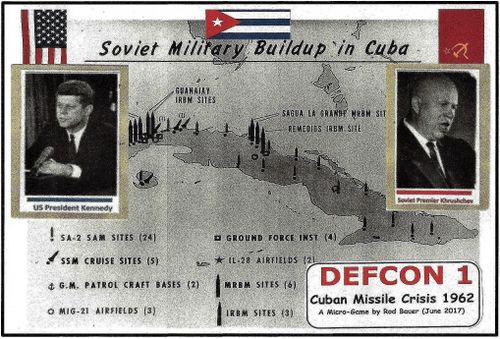|
Advertisement
|
DEFCON 1: Cuban Missile Crisis 1962
DescriptionDescription from the designer: The time is October 1962. The players, representing Kennedy , Khrushchev, and Castro, must try to survive each of the 5 Rounds of the Cuban Missile Crisis while gaining more prestige than your opponents. The game consists of three phases in each of the five Rounds: Decision Phase, Conflict Phase, and Resolution Phase. The US and Soviet players will use “brinkmanship” as they commit resources during the Decision Phase, in which they try to gain an advantage without resulting in a confrontation (referred to in the rules as a Deadlock or Stalemate). During the Conflict Phase, there is a danger that DEFCON 1 might be reached which means imminent nuclear war in which all sides will lose prestige (victory points). Only if the contestants can work their way successfully through the Conflict phase, without triggering a nuclear war, will they score victory points (prestige) in the Round. During each Round, each player is required to make one major decision. Then, through the use of tactical cards, the Kennedy and Khrushchev players may make a few further crucial decisions to best implement their chosen strategy for the Round. ANY of these Decisions have the capacity to trigger the disaster of Nuclear War, which results in the loss of prestige or victory points (not to mention human life). Be careful! Who is willing to push the envelope to the brink of disaster in an effort to emerge from the crisis as the world’s dominant power?Decision Phase:
The tactics cards represent actual historical events of the period. This micro-game is designed to accurately reflect a brief history of the Cuban Missile Crisis. The entire game can be played within 15 to 20 minutes. Game DiscussionsAdd CommentYou need to be logged in to comment. Insert Bullet List Please enter at least one item. Item: Item: Item: Item: Item: Insert Numeric List Please enter at least one item. Item: Item: Item: Item: Item: Insert Link Please enter the link of the website Optionally you can add display text Insert Email Please enter the email address Optionally add any display text Insert Image Please enter the link of the image Insert YouTube Video Please enter the link of the video Marketplace |


Comments (0)